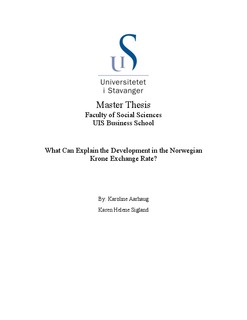| dc.contributor.advisor | Mohn, Klaus | |
| dc.contributor.author | Aarhaug, Karoline | |
| dc.contributor.author | Sigland, Karen Helene | |
| dc.date.accessioned | 2016-08-25T10:10:54Z | |
| dc.date.available | 2016-08-25T10:10:54Z | |
| dc.date.issued | 2016-06-15 | |
| dc.identifier.uri | http://hdl.handle.net/11250/2401625 | |
| dc.description | Master's thesis in Finance | nb_NO |
| dc.description.abstract | This thesis analyzes the effects of the oil price, Norwegian CPI, euro area harmonized CPI, interest rate differential, balance of trade and the unemployment rate on the NOK/euro exchange rate. Using an Engle-Granger two-step approach, we were able to estimate the long and short-run effects of these independent variables on the exchange rate. The data set consists of monthly data from 2001-2015. In addition to the main research question, the results from step one of our Engle-Granger approach are discussed in light of the purchasing power parity and the uncovered interest parity theorems.
In the first step of the Engle-Granger two-step approach, we found all of our variables to be significant, which proved them to have a causal relationship with the exchange rate in the long run. Further investigation, the second step of the Engle-Granger procedure found evidence of the speed of correction towards the long-run equilibrium exchange rate level. The second step of the procedure included the lagged independent changes in the variables effects on the exchange rate. However, we did not find significant evidence on the effect of lagged independent variables changes in our estimates. Accordingly, our model was unable to prove the short-run impact on the exchange rate when there is a deviation from the long-run equilibrium level. Moreover, when examining our results in light of purchasing power parity, we did not find support of the theorem. Our estimation did not indicate that the exchange rate equates the purchasing power of a unit currency in the foreign and domestic economy. Discussing the results with regards to uncovered interest parity, we did not find evidence in support of the theorem. As proof of uncovered interest parity is not provided within our estimation, it denotes that there is an opportunity to profit through exchange rate speculation. | nb_NO |
| dc.language.iso | eng | nb_NO |
| dc.publisher | University of Stavanger, Norway | nb_NO |
| dc.relation.ispartofseries | Masteroppgave/UIS-SV-HH/2016; | |
| dc.rights | Navngivelse 3.0 Norge | * |
| dc.rights.uri | http://creativecommons.org/licenses/by/3.0/no/ | * |
| dc.subject | økonomi | nb_NO |
| dc.subject | administrasjon | nb_NO |
| dc.subject | business administration | nb_NO |
| dc.subject | macroeconomics | nb_NO |
| dc.subject | makroøkonomi | nb_NO |
| dc.subject | valutakurs | nb_NO |
| dc.title | What Can Explain the Development in the Norwegian Krone Exchange Rate? | nb_NO |
| dc.type | Master thesis | nb_NO |
| dc.subject.nsi | VDP::Social science: 200::Economics: 210::Economics: 212 | nb_NO |

